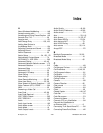Glossary
ViewStation User Guide 222 www.polycom.com
ISP Internet Service Provider.
IMUX Inverse Multiplexer. Equipment that
combines 64Kbps channels and presents
them to the user's terminal equipment as if
they were a single larger bandwidth channel.
IP Internet Protocol. An IP address is a number
that identifies a computer connected to the
Internet. Every computer that is connected to
the Internet must have unique IP address.
Currently, an IP address consists of four
sections separated by periods. Each section
contains an 8-bit value represented as a
number ranging from 0 to 255. The allocation
of these IP addresses follows a two-level
architecture that assigns IP numbers to a
network and the hosts on that network.
IP Precedence IP precedence tells downstream networking
equipment (mainly routers) to give priority to
audio and video data. It marks each audio
and video packet with a user-defined
precedence (the default is 4). Only audio,
video, and far-end camera control-packets
are marked. Control packets (such as
opening and closing of connections,
channels, etc.) are not marked with
precedence.
The user may specify any one of 8 levels
(0-7) of precedence with 0 signifying no
priority and 7 signifying the highest priority.
It is recommended by networking equipment
vendors to use 4 for multimedia data. By
default, IP precedence is disabled by most
routers and is not enabled on the Internet.
ISDN Integrated Services Digital Network. Fully
digital telephony service, available at 128
Kbps (BRI), 1.544 Mbps (PRI), and


















